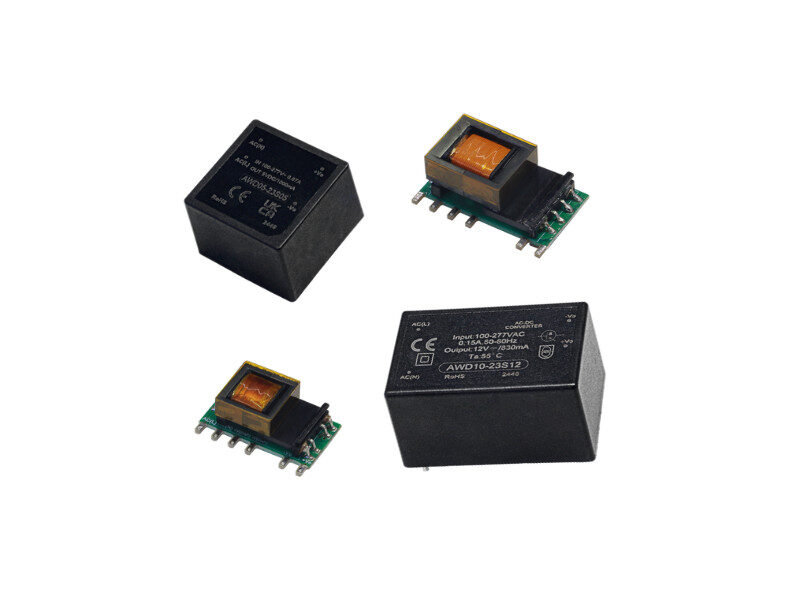Key Takeaways
-
The ACDC Print Module is a board-mounted modular power supply designed for demanding environments, with a wide input range (85–305 VAC, 100–430 VDC) and extended temperature capability (up to -40°C to +85°C, depending on model).
-
Its compact, PCB-mountable design enables efficient AC-DC conversion directly on the board, reducing wiring effort and simplifying integration in industrial and outdoor systems.
-
Key advantages include wide-range AC/DC compatibility, robust construction for harsh conditions, and alignment with common industrial requirements—making it suitable for industrial automation, energy, transportation and remote monitoring systems.
-
Thermal management, protection functions and stable regulation support reliable performance under temperature variations, voltage fluctuations and environmental stress.
-
Understanding the differences between board-mounted modular PSUs, standard PCB AC/DC supplies, and external or fully modular PSUs helps engineers select the right solution for harsh-environment designs.
Extreme Environment Power Demands for Circuit Boards
Circuit boards in harsh environments—ranging from very low to high temperatures, vibration, pollution, salt mist or unstable input power—require stable and durable on-board power.
A failure of the PCB power supply in such applications can lead to:
-
unplanned downtime
-
costly service interventions
-
potential safety or compliance issues
The ACDC Print Module is designed for these conditions as a board-mounted AC-DC module that can be integrated directly into demanding PCB designs.
Limitations of Conventional AC/DC Power Supplies
Conventional AC/DC power supplies or simple PCB modules are often optimized for:
-
indoor environments
-
moderate temperatures
-
stable grid inputs
Typical limitations include:
-
narrow input voltage ranges
-
restricted operating temperature (e.g. 0–40°C)
-
limited protection and mechanical robustness
In harsh environments, this can cause derating, reduced lifetime or premature failure. The ACDC Print Module addresses these constraints with wide input ranges, extended temperature capability and robust mechanical design for PCB integration.
Guide Overview
This guide explains how the ACDC Print Module supports board-level power conversion in harsh environments, covering:
-
fundamental concept and design benefits
-
core technology (input range, temperature behavior, protection)
-
key specifications relevant for extreme environments
-
typical applications and integration scenarios
-
comparison with other power supply concepts

Introduction: What Is an ACDC Print Module?
An ACDC Print Module is a compact, encapsulated AC-DC converter designed for direct mounting on a printed circuit board.
Key characteristics:
-
AC-DC conversion on-board – no separate open-frame or external PSU required.
-
Industrial-grade design – suitable for applications with vibration, fluctuating input voltages or wider temperature ranges.
-
Space-efficient integration – ideal for dense control boards and distributed electronics.
Unlike many consumer-grade AC/DC modules or plug-in adapters, ACDC Print Modules are developed for industrial and outdoor use, where exposure to dust, humidity, mechanical stress or unstable input power is common.
Core Design Advantages for PCB Integration
Board-Mountable Form Factor
Available in through-hole and/or SMT variants to fit standard PCB manufacturing and assembly processes.
Scalable Architecture
Multiple modules can be used in parallel or distributed across the system to supply different loads and power domains.
Serviceability
Defective modules can be selectively replaced on the PCB instead of exchanging an entire external power unit, helping to minimize downtime where access is limited.
These properties support reliable operation in systems with restricted maintenance windows or remote installation sites.
Growing Demand for Ruggedized PCB Power Solutions
With increasing deployment of electronics:
-
in outdoor cabinets
-
in distributed sensor networks
-
in transportation, energy and infrastructure systems
the demand for robust, board-mounted power modules is rising. Such solutions must tolerate:
-
large temperature swings
-
unstable or noisy input sources
-
mechanical vibration
-
moisture, dust or pollution
The ACDC Print Module is designed with these requirements in mind.
Core Technology: How ACDC Print Modules Achieve Reliability
Wide Input Voltage Range
Typical ACDC Print Module variants support:
-
85–305 VAC for global mains and generator operation
-
100–430 VDC for DC buses, renewable sources or buffered systems
Benefits:
-
one platform for different regions and input conditions
-
improved tolerance to fluctuations and brownouts
-
simplified design in hybrid AC/DC systems

Extended Temperature Capability
Selected ACDC Print Module models are specified for operation from -40°C to +85°C (depending on type and load profile).
Design elements include:
-
components rated for extended temperature ranges
-
construction and layout that support effective heat dissipation
-
compatibility with system-level cooling concepts
This reduces derating requirements and supports reliable operation in enclosed housings and outdoor applications.
Modular Design and Redundancy Options
The modular, board-mounted concept enables:
-
Redundancy – multiple modules in parallel for higher availability
-
Scalability – simple adaptation to changing load requirements
-
Targeted replacement – individual module exchange without altering enclosure or complete power architecture
This is particularly attractive in mission-critical systems where downtime is costly.
Integrated Protection and EMC Measures
ACDC Print Modules typically include:
-
overvoltage and undervoltage protection
-
short-circuit and overcurrent protection
-
thermal shutdown / overtemperature protection
-
inrush and surge limitation
-
EMC-optimized design to support compliance with relevant standards
These functions help protect both the module itself and the connected PCB components.
Key Specifications for Extreme Environment PCB Integration
Input Voltage
-
85–305 VAC
-
100–430 VDC
This covers common global mains and many DC bus scenarios, reducing the need for additional conversion stages.
Operating Temperature
-
Up to -40°C to +85°C (depending on model and load profile)
Engineers should always refer to the specific module datasheet and derating curves for the intended operating conditions.
Output Voltage and Power Classes
Available with common output voltages such as:
-
12 VDC
-
24 VDC
-
48 VDC
and various current ratings for sensors, logic, communication, control and actuator loads.
Stable output regulation supports sensitive electronics and communication interfaces.
Efficiency
High-efficiency designs (up to approx. 95%, depending on type and operating point) help:
-
reduce heat generation on the PCB
-
increase overall system efficiency
-
extend component lifetime
Mechanical and Environmental Design
-
Compact, encapsulated housings suitable for PCB mounting
-
Design options for increased resistance against dust, humidity and vibration
-
Compatible with standard THT and SMT assembly processes
If specific IP ratings or environmental and vibration standards (e.g. MIL-STD-810) are supported, they should be documented in the relevant datasheets and communicated precisely.
Typical Applications
Aerospace, Transportation and Demanding Embedded Systems
-
control and monitoring electronics
-
systems exposed to vibration and temperature fluctuations
Benefits: compact footprint, extended temperature range, integrated protection.

Oil & Gas and Heavy Industry
-
offshore platforms
-
refineries
-
desert installations
Benefits: tolerance to unstable supply conditions, high operating temperatures and harsh atmospheres.
Renewable Energy (Solar, Wind, Storage)
-
control boards in inverters and charge controllers
-
monitoring and communication PCBs in remote installations
Benefits: support for wide DC input ranges (where applicable), robust design, easy integration.
Industrial Automation & Outdoor Equipment
-
PLC and I/O modules
-
machine and process controllers
-
outdoor kiosks, terminals and charging systems
Board-mounted modules save space, simplify wiring and support sealed housing concepts.
Comparison with Other Power Supply Concepts
Versus Standard PCB AC/DC Power Supplies
Standard modules:
-
often limited in input and temperature range
-
designed mainly for controlled indoor environments
ACDC Print Modules:
-
extended ranges (where specified)
-
more robust protection and mechanical concepts
-
better suited for harsh or outdoor use cases
Versus Modular PC Power Supplies
Modular PC PSUs:
-
optimized for desktop PCs and cable management
-
not PCB-mounted; not designed for industrial harsh environments
ACDC Print Module:
-
compact, board-mounted
-
developed for industrial and embedded systems
Versus External AC/DC Adapters
External adapters:
-
limited temperature range
-
additional connectors and cables as potential failure points
ACDC Print Module:
-
sits directly on the PCB
-
reduces interfaces and wiring effort
-
supports integration in sealed systems
Versus Fully Modular PSUs (Data Center / Server)
Fully modular PSUs:
-
suited for rack and server environments
-
mechanically and electrically oversized for embedded devices
ACDC Print Module:
-
tailored for embedded, distributed and outdoor electronics
-
optimized for space-constrained and rugged applications
Frequently Asked Questions (FAQ)
Can the ACDC Print Module be directly mounted on a PCB?
Yes. It is designed for PCB mounting and is typically available in THT and/or SMT variants compatible with standard assembly processes.
Is it suitable for extreme temperatures?
Selected models are specified for extended temperature ranges, for example up to -40°C to +85°C. Always check the corresponding datasheet and derating curve.
How does the modular concept improve reliability?
Multiple modules can be used for redundancy or segmented loads. In the event of a fault, individual modules can be replaced without redesigning the overall power architecture.
Which protection functions are integrated?
Depending on the model, typical features include overvoltage, overcurrent, short-circuit and thermal protection as well as EMC-optimized layouts. Exact specifications are defined in the product documentation.
Conclusion: A Robust Board-Mounted Power Solution for Harsh Environments
For applications where PCB-mounted power reliability is critical, the ACDC Print Module offers a compact, scalable and robust solution:
-
wide input ranges for global and unstable supplies
-
extended temperature capability (per model)
-
integrated protection and high-efficiency design
-
seamless PCB integration for industrial and outdoor systems
By shifting AC-DC conversion directly onto the circuit board with a suitable ACDC Print Module, engineers can increase system reliability, simplify layouts and better meet the demanding requirements of harsh and remote environments.



